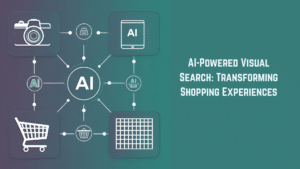The AI-powered visual search technology is changing the landscape of online shopping. AI technology is deeply integrated into our daily activities. With the overwhelming popularity of mobile shopping applications, consumers are constantly looking for AI visual search features that optimize convenience and time efficiency. In this article, I will provide details on the AI visual search technology, its application in eCommerce, how to implement it, examples of use, and how it fares against conventional search techniques.
What is AI Visual Search and How Does It Work?
Understanding Visual Search Technology
Rather than a text-based query, users can search for products using images through visual search technology. This technology solution aids and utilizes artificial intelligence as well as sophisticated image analysis capabilities to interpret visuals and enables people to discover products easily. Shoppers can take photos or upload them from their devices, which prompts a search that returns appropriate results. The application of visual tools changes the way people shop online, and with the help of AI algorithms, the efficiency and reliability of the results are enhanced.

The Role of Image Recognition in Visual Search
Text-based search engines are given power because of image recognition, and image recognition is a computer vision-based system that analyzes the visual data for patterns, colors, shapes, and other features of the images that were uploaded. Such analysis aids the AI image search engine in contending with the user’s image and comparing it with the visual features of the products in the retailer’s catalog. This way, the shoppers are able to locate products that are similar to the images they provide, thus improving their shopping experience. With the technology of image recognition, the technology of visual search is more advanced than before, and it is able to conduct searches in a refined manner that gives accurate results.
AI-Powered Algorithms Behind Visual Search
The effectiveness of AI-powered visual search lies in the algorithms that work behind its operations. The algorithms use processes and techniques, including user interaction, which help improve system performance over time. To include machine learning, the AI system can identify and classify numerous products better while also improving understanding of what the users intend through visual aids. This visual recognition enhances search result accuracy and relevance while also tracking shifts in consumer preference trends so that preferred products appeal to the users while shopping online.
What Are the Benefits of Visual Search in Ecommerce?
Enhancing Customer Experience with AI Visual Search
AI visual search significantly enhances the customer experience by providing users with a seamless and intuitive way to find products. Instead of relying solely on traditional keyword searches, which can often lead to irrelevant results, visual search helps users to search using familiar imagery. This aspect is particularly beneficial for visual learners and those who may struggle with descriptive language. By allowing shoppers to upload images or use functionalities like Google Lens or Pinterest Lens, retailers can create a more engaging and user-friendly shopping experience, ultimately fostering greater customer satisfaction and loyalty.
Improving Product Discovery Through Visual Search Tools
Product discovery is crucial for eCommerce success, and visual search tools excel in this area. Traditional text-based searches may overlook products that don’t match specific keywords, but visual search capabilities allow users to find products based on visual similarities. This enhances the likelihood of discovering new items that users may not have considered. For instance, if a shopper uploads a photo of a dress they admire, the visual search engine can present similar styles, colors, or brands, broadening their shopping options. This capability not only aids customers in finding products but also encourages impulse buying, ultimately driving sales for retailers.
Boosting Conversion Rates with Effective Image Search
Implementing effective image search technology can lead to significantly higher conversion rates. When customers can easily find products that match their needs visually, their likelihood of making a purchase increases. Visual search helps to reduce friction in the shopping process by minimizing the steps needed to locate desired items. Additionally, by presenting visually similar alternatives, retailers can capitalize on opportunities to upsell or cross-sell products, thus maximizing revenue potential. As eCommerce becomes increasingly competitive, businesses that harness the benefits of visual search are more likely to see improved customer engagement and higher conversion rates.
How to Implement AI-Powered Visual Search in Your Online Store?
Choosing the Right Visual Search Engine
When considering the implementation of AI-powered visual search technology, selecting the right visual search engine is paramount. Various options are available, each offering unique features and capabilities. Retailers should evaluate their specific needs, such as the types of products they offer and their target audience’s preferences. Factors like the accuracy of image recognition, ease of integration, and support for different visual content formats should all influence the decision. By choosing the right visual search engine, businesses can ensure that they are equipped to provide an outstanding search experience.
Integrating Visual Search Technology into Your Website
Integrating visual search technology into an online store requires careful planning and execution. Retailers should work closely with their web development teams to ensure that the visual search tool is seamlessly incorporated into their existing platform. This might involve adding a dedicated search bar for image uploads, ensuring that product images are optimized for recognition, and creating a user-friendly interface that guides customers through the search process. Ensuring compatibility across devices is also crucial, as many users will access the visual search functionality via mobile. Proper integration can significantly enhance the overall search experience and encourage more users to engage with the visual search capabilities.
Best Practices for Using Visual Search in Ecommerce
To maximize the impact of AI-powered visual search, retailers should adopt best practices that enhance its effectiveness. First, it’s essential to maintain high-quality product images that are clear, well-lit, and accurately represent the items. This not only aids in image recognition but also improves the user’s perception of the products. Additionally, providing contextual information about products can enrich the search capabilities and guide users toward informed purchasing decisions. Regularly analyzing user interactions and search results can help retailers identify trends and make necessary adjustments to optimize the visual search tool continually.
What Are Some Use Cases for AI Visual Search in Retail?
Case Studies of Successful Visual Search Implementations
Numerous retailers have successfully implemented AI visual search technology to enhance their eCommerce platforms. For instance, major fashion retailers have adopted visual search tools that allow customers to upload images of clothing items they like. The visual search engine then generates a list of similar products available for purchase. These implementations have demonstrated significant increases in customer engagement and sales, showcasing the potential of visual search in driving business success.
How Brands are Using Visual Search to Drive Sales
Brands across various sectors are leveraging visual search to drive sales by creating more personalized and relevant shopping experiences. For example, home decor retailers use visual search technology to allow customers to find furniture and decor items that match their uploaded images. This not only simplifies the product search process but also enhances the likelihood of conversion as shoppers can visualize how products fit into their spaces. By tailoring visual search capabilities to their specific products, brands can meet customer expectations and boost sales effectively.
Innovative Applications of Computer Vision in Shopping
Beyond traditional applications of visual search, innovative uses of computer vision technology are emerging in the retail space. For instance, augmented reality (AR) applications allow users to visualize products in their environment, enhancing the shopping experience further. Brands are also exploring the integration of visual search with social media platforms, enabling users to search for products directly from images they encounter online. These innovative applications not only enrich the shopping experience but also position brands as forward-thinking leaders in the industry.
How Does AI-Powered Visual Search Compare to Traditional Search?
Differences Between Visual Search and Keyword Search
AI-powered visual search and traditional keyword search differ fundamentally in their approach to product discovery. While keyword search relies on text-based queries that can often lead to ambiguous results, visual search allows users to engage with products through imagery. This difference is crucial, as many consumers may not know the exact terminology to describe what they are looking for. Visual search eliminates this barrier, providing a more intuitive method for users to find products based on what they see.
Advantages of Using Visual Search Tools Over Traditional Methods
The advantages of using visual search tools over traditional methods are significant. Visual search helps users to search more efficiently, reducing the time spent sifting through irrelevant search results. Additionally, it opens up opportunities for serendipitous discovery, as users may find products they weren’t specifically looking for but are nonetheless appealing. Moreover, visual search capabilities can position brands as innovators, demonstrating a commitment to enhancing the customer experience through advanced technology.
Future Trends in AI Visual Search Technology
The future of AI visual search technology is bright, with potential trends indicating its expansion and integration into various aspects of eCommerce. As machine learning algorithms continue to evolve, we can expect even greater accuracy in image recognition and personalization in search results. Furthermore, the integration of visual search with other technologies, such as voice search and AR, could lead to hybrid shopping experiences that are more interactive and immersive. Retailers who embrace these advancements will likely stay ahead of the competition, offering cutting-edge solutions that meet the evolving needs of consumers.
Conclusion
Lastly, tracking and fine-tuning the scoring methodology is crucial for predictive lead scoring refinement. Feedback from the sales team regarding the usefulness of leads generated as per the scoring system should be analyzed for gaps or areas of improvement. Periodic assessment of performance benchmarks for the AI lead scoring model in relation to real-world conversion figures will Determine trends and provide intervention to the algorithm where necessary. Through ongoing evaluation and improvement, organizations can ensure their AI lead scoring adapts to changes that affect sales outcomes.



